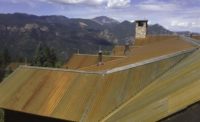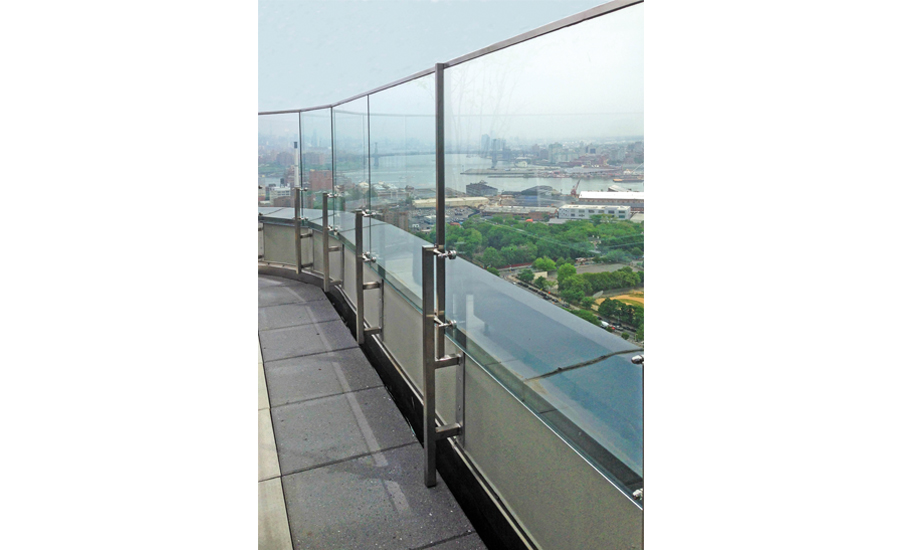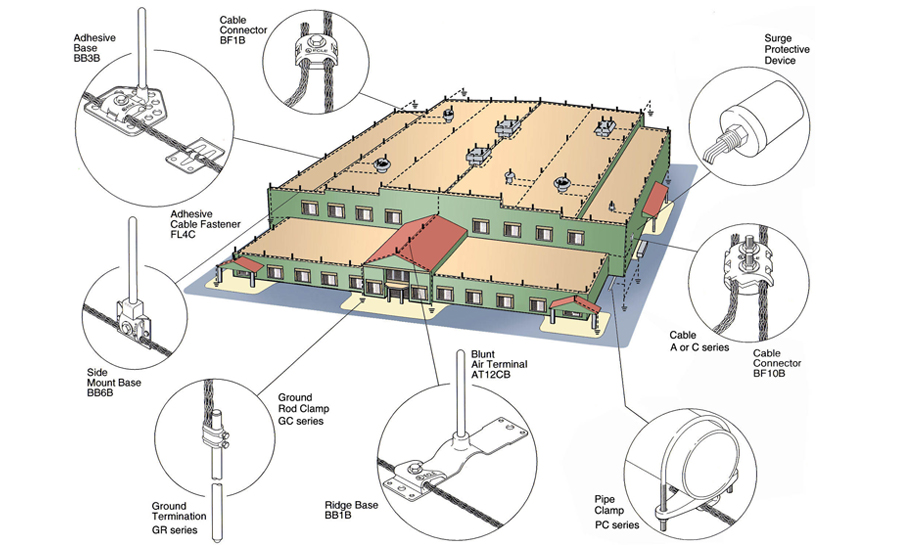Lightning Protection Systems
Both Roofs and Lightning Protection Systems Protect Buildings Against Weather Damage

To maintain clear sight lines around this roof top terrace in Brooklyn, N.Y., the top rail of the wind screen was made electrically continuous to act as an alternative strike termination device and eliminate the need for traditional air terminals. Posts carry current from a lightning strike to ground conductors located beneath the paving stones. Photo courtesy of Associated Lightning Rod Company.

HVAC equipment, antennas, flashings and other fixtures on the roof of this pharmaceutical lab in Cambridge, Mass. are surmounted with air terminals and connected to ground via conductors. Photo courtesy of Boston Lightning Rod Company.

Lightning protection conductors are typically installed inside the building where they are not visible. Where conductors are exposed, however, their appearance can still be minimized. On the lower roof, for example, a conductor is tucked against ridge shingles; on the backside of the chimney, a conductor is installed along the masonry’s edge. The copper cables will form a patina that will harmonize with the shingles as they age. The cables are tinned, however, on the chimney so they are less visible against the light-colored stone and sky. Photo courtesy of Mr. Lightning.


A lightning protection system was recently installed on the existing Virginia Museum of Art. Air terminals were installed around the perimeter of the roof and on top of skylights, HVAC equipment, and other prominences, then connected with grounding conductors. Despite the complexity of the roof, the installer did not need to make new penetrations through the roof nor run exposed cables on the building’s walls. Instead, down conductors were run through abandoned roof vents and other existing openings. Photo courtesy of Loehr Lightning Protection Co.

NFPA, UL and LPI standards require air terminals within 24 inches of gable ends and as required by “rolling sphere” calculations. The weathered-looking roof is actually on a newly constructed resort in the mountains above Colorado Springs, Colo. Photo courtesy of Mr. Lightning.

This project, at O’Hare Airport in Chicago, demonstrates one technique for installing lightning protection equipment on an earth-covered roof. Conductor cables are installed prior to placing turf and air terminals placed in wells. Other techniques allow cables and air terminals to be installed above plantings. Photo courtesy of HLP Systems Inc.







Rain, snow and lightning—each originates in the clouds and can damage buildings that are not properly protected. Just as roofs safely move water to the ground, lightning protection systems (LPS) do the same with the 300 million volts of electricity in a lightning strike.1
According to the National Weather Service, “Lightning is the most underrated weather hazard. In the United States, lightning routinely kills more people each year than tornadoes and hurricanes combined.” In addition to fire and physical damage, lightning can destroy the electronic devices necessary for building operation, safety and security. In a typical year in the U.S., lightning is responsible for over $1 billion of residential insurance claims and $108 million in direct property damage to non-residential buildings.
Climatologists forecast the frequency of lightning will increase with global warming. Meanwhile, the cost of installing lightning protection is modest, and an LPS will last the life of a structure with minimal maintenance.2
Because both roofing and lightning protection equipment occupy places of honor at the top of buildings, they have to work together to protect buildings, and their contents and occupants.
Components
Three basic types of lightning protection components are installed on rooftops:
1. Air Terminals: Air terminals, formerly called lightning rods, rise at least 10 inches above a roof to provide a contact point for electrical charges approaching a building. The National Fire Protection Association’s NFPA 780—Standard for the Installation of Lightning Protection Systems requires air terminals to be located at 20 feet on-center maximum along ridges, parapets, and other high points on a building. A “rolling sphere” analysis will determine where air terminals are also required on rooftop equipment, along eaves, and within the field of the roof. Despite extravagant claims offered by some manufacturers, these spacings also apply to so-called “early streamer emission” and “charge transfer system” air terminals.
Air terminals are typically copper or aluminum and should be selected based on roofing type and adjacent materials. For example, aluminum must be used if the roofing or flashings are steel, aluminum or aluminum-alloy coated. Where roof-mounted window-washing equipment will be used, spring-mounted air terminals are recommended to reduce potential damage.
2. Conductors: Air terminals are interconnected connected via conductors that lead to ground. A lightning strike can release 300 million volts and 30,000 amperes, so conductors are sized to provide a low-resistance path from air terminals to ground. Conductors can be installed in direct contact with combustible materials and do not require thermal or electrical insulation. Conductors are typically multi-strand cables; metal straps or rods can be used for special situations.
3. Penetrations: Through-structure penetration devices may be required where conductors penetrate the roof. Boots, flashings and other standard roofing details should be used to protect the water-resistant or water-shedding layer of the roofing system.
LPS components must be listed for compliance with UL 96—Standard for Lightning Protection Components—and adequately secured. Air terminals are generally affixed with metal castings; conductors with either castings or stamped metal parts. These fittings are typically adhered to roof membranes with construction-grade adhesives; screws or mechanical anchors can also be used when mounting to walls or surfaces that can be penetrated.
Coordination
The lightning protection installer, roofer and roof manufacturer must coordinate their work to assure the project will be successful. The methods of attachment, for example, must be acceptable to the roofing product manufacturer so the roof warranty remains valid. The LPS installer may need to install penetrations before roofing is laid, and must mark penetrations locations so they can be found afterwards.
The LPS must also be coordinated with rooftop HVAC units, skylights, roof ladders, antennae, and other metal bodies on a roof—they may require air terminals and bonding in accordance with design standards. In addition, surge protection devices are required at every location where wires enter the building.
To be assured of protection, a building owner should require the LPS to be inspected and certified by the Lightning Protection Institute-Inspection Program. The building maintenance staff and vendors working on the building must exercise care to avoid damaging the LPS, and the building owner should have the system recertified every three years.
Coordination is especially important on re-roofing, remodeling and maintenance projects. An LPS installer should remove the existing LPS prior to roof work in order to protect reusable components and to mark and preserve through-roof penetrations. After the new roof is installed, the LPS installer can reinstall, modify and extend the LPS to assure the system qualifies for recertification.
Architectural Considerations
Typical air terminals have limited architectural impact since they are short, slender, located primarily on the highest points of a roof, and can be set 2 feet in from roof edges. Alternatively, air terminals can be incorporated into ornamental or sculptural elements. Conductors can usually be run inside the walls of the building; in situations where they must be run on the outside of a building, they should be located in inconspicuous locations away from the main facade of the building and tucked against the existing lines of the roof or wall.
Lightning protection has kept pace with trends such as rooftop solar collectors and earth covered roofs. Rooftop terraces have become a popular amenity in high-rise apartment buildings. To assure the clean sight lines desired in these locations, NFPA 780 has criteria that allow the use of railings and other structural elements as alternative strike termination devices instead of traditional air terminals and conductor cables.
In most jurisdictions, lightning protection is not required by the building or electrical codes. Instead, the mandate to protect the public health, safety and welfare requires an architect to assess a building’s risk and advise the building owner accordingly. NFPA 780, Annex L—Lightning Risk Assessment can be used for this purpose.
On most projects, it is not necessary for the architect to design the lightning protection system. Instead, project specifications should delegate the design to an individual with the Lightning Protection Institute’s Master Installer/Designer certification and require that the project comply with NFPA, UL and LPI standards.3
Designing a building that sheds both water and lightning protects the top line of an architect’s reputation.
References
1. An in-depth article about lightning protection and architectural considerations can be downloaded at www.ecle.biz/ConstructionSpecifier.pdf.
2. A construction cost estimating guide is at www.ecle.biz/coststudy.
3. A guide specification can be downloaded at www.ecle.biz/guidespec.doc.
Looking for a reprint of this article?
From high-res PDFs to custom plaques, order your copy today!












